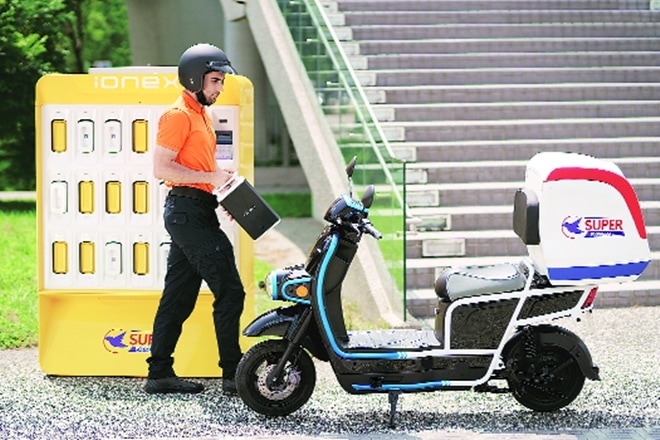Kymco, short for Kwang Yang Motor Co, is a Taiwanese electric two-wheeler major that is entering India by partnering with Twenty Two Motors—the Indian electric two-wheeler startup—this week. Allen Ko, the global Chairman of Kymco, says that the company’s solutions called Ionex and Ionex Commercial—which include both product and replaceable batteries—are appropriate even for markets where there is minimal charging infrastructure. In an interview with FE’s Vikram Chaudhary, he shares why traditional companies are not yet entering the electric scooter space, why two-wheelers will be far ahead of four-wheelers in electric transition, and why its solution will work in India. Excerpts:
In India, two companies have captured a large chunk of the two-wheeler market, and it is almost entirely made up of petrol engine vehicles. What scope does a new electric scooter company such as Kymco have?
India is a big market and there is space for everyone. Our solution, especially the Ionex Commercial, can make electric a practical reality. Consider this: Globally, 150 million scooters are roaming the streets, and 5 million of these are used for commercial purposes. These travel, on average, seven times the distance of their personal-use counterparts, and are replaced two times more frequently. While they form a minuscule part of total scooters, they consume 20% of total energy. The data won’t be much different for India.
Also, unlike personal-use vehicles, the procurement of entire fleets of commercial scooters is generally managed by a few decision makers. So, a conversion of even a small number of businesses to go electric can make a big impact on the environment, and emissions. The commercial electric scooter market, that’s why, is going to be one of our focus areas.
Which are these businesses who can go electric?
Four types of enterprises can easily join the electric scooter movement. These are petroleum companies, logistics and retail companies, ride-sharing startups, and city governments.
Petroleum companies can be at the centre of transition to electric. While their existing fuelling infrastructure can keep serving gasoline vehicles, they have extensive service networks that can be leveraged to serve electric scooters. This transition to electric is an opportunity for them to extend their revenue generation models.
Logistics and retail companies also benefit. One, in-house charging stations eliminate the trips to gas stations. Two, simpler construction of electric scooters means lower maintenance costs. Three, minimal vibration from electric scooters elevates the working conditions of the fleet’s employees.
Ride-sharing startups are welcomed by consumers and supported by governments. And city governments want more people to use public transport. But the problem is that people’s willingness to use it drops off significantly when they need to walk more than 10 minutes to the nearest station. Station-based shared electric scooter rental can solve this last-mile problem.
But this last-mile problem can be solved by bicycles also…
It can be, but it’s not always practical. Studies show that a convenient distance (say, from home to a metro station) that people prefer travelling on bicycles is about 2-km. If it’s longer, people use cars or two-wheelers. That’s where we want to step in. Moreover, it’s tough to carry luggage and a partner on a bicycle.
Do people really want electric scooters?
Yes, but they don’t have a reliable solution. They need a good model that is not so expensive and is convenient. Once it is there, people will actively consider electric scooters. I must say we have that model.
Which is the ideal vehicle for electric transition?
Two-wheelers will be far ahead of four-wheelers in electric transition because a majority of two-wheelers are used for pure mobility needs. Moreover, in today’s congested cities, two-wheelers are far more practical for short-distance travel, which is what the masses do.
Can the Ionex Commerical solution be replicated for cars?
Even though the backend platform is the same, the removable battery solution cannot be replicated for cars.
Once the big names such as Honda and Hero enter the electric scooter race, will that pose a major challenge to companies such as Kymco?
I’m sure they’d have power, resources and network at their disposal, but I don’t see any of the big global brands entering the segment. I think that, at present, from their perspective, the electric scooter market is not even 1%, so why focus on that tiny chunk? Also, perhaps they think that since no electric company is making money out of pure vehicle sales, why should I cannibalise my profitable gasoline two-wheeler business?
They might enter in a big way only if there is a strong policy directive from governments. Lastly, it’s just too difficult for a traditional vehicle manufacturer to understand electric, which consists of battery, software, apps, cloud and IoT, apart from the vehicle. Electric vehicle manufacturing and sales & service is an entirely different culture.
What makes you so confident about the Indian market?
Today is the best time to enter the electric scooter space. India is a complex market, but there is a huge opportunity also—if you succeed, chances are you will remain dominant for a very long time. Right now, the electric scooter segment is empty, a blank sheet, waiting for a player such as Kymco to fill it up. And our focus will be both on personal and commercial electric scooter space. They are parallel.

